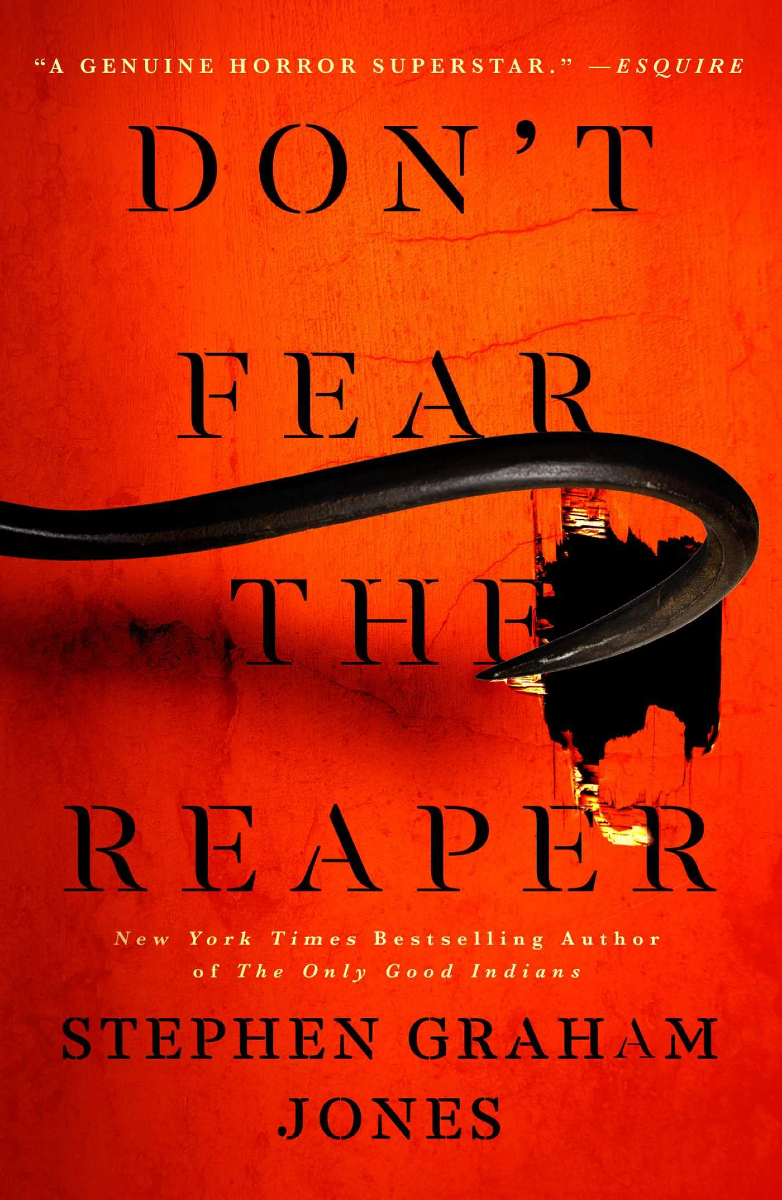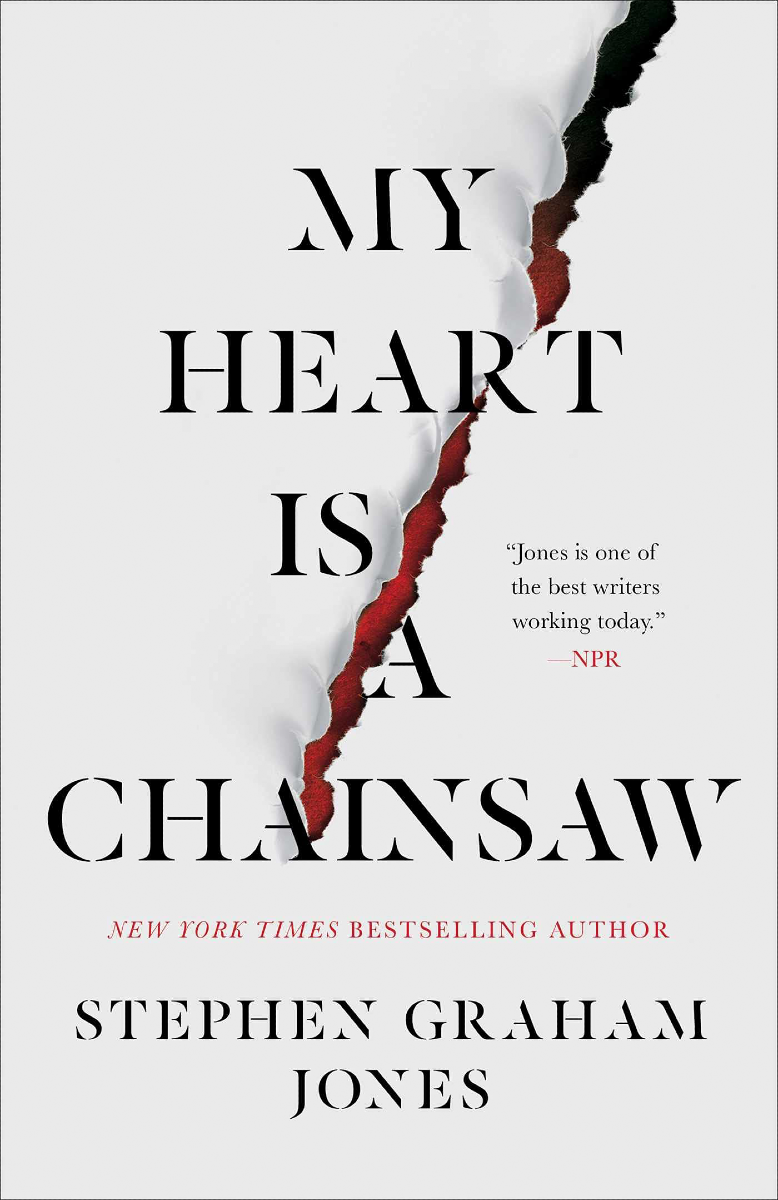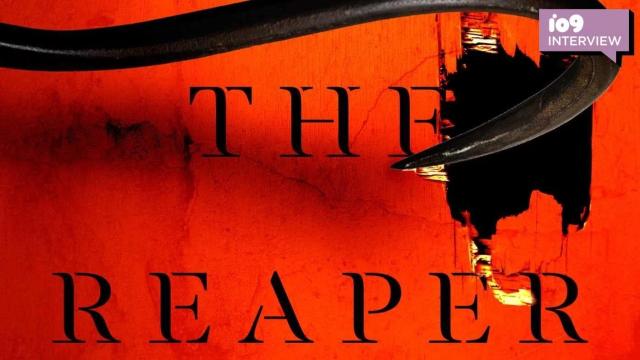In 2021, author Stephen Graham Jones (The Only Good Indians) released My Heart Is a Chainsaw, giving horror fans a memorable heroine in high school misfit Jade Daniels. Don’t Fear the Reaper, its sequel and the second entry in Jones’ Indian Lake Trilogy, is out today — and i09 got a chance to talk to him about it.
In the Bram Stoker Award-winning Chainsaw, Jade’s obsession with slasher movies begins to bleed into real life when she becomes convinced a maniac is stalking her small Idaho town, a place with a rich and troubled history where she’s one of few Indigenous residents remaining. In Reaper, we find Jade returning home a few years after the events of Chainsaw, right when a dangerous new threat appears in the form of an escaped serial killer. Both books are infused with Jones’ own love of (and deep knowledge of) horror films, as well as themes that reflect his Native American background. What follows is a slightly edited and condensed version of our interview with Jones.
Cheryl Eddy, Gizmodo: Jade has been through a lot since the end of My Heart Is a Chainsaw. What do you think was the most important lesson she took away from the events of that book? And how has it shaped her going into Don’t Fear the Reaper?
Stephen Graham Jones: At the end of Chainsaw, and this may be a spoiler for people who haven’t read it, she does kind of save the day — but she doesn’t get credit for it. From that, she might have learned that it’s not about whether the world acknowledges you, it’s about whether you do what you think is right. Jade pretends to be all anti-society and metal and everything against the world, but I think secretly she wants to make it a better place. She wants to help people and just make things better. I think she might be slowly realising that you don’t do it for the credit. You do it for the good it does.
Gizmodo: Why do you think she has such a hard time seeing herself as a Final Girl?
Jones: I think because over the decades — and she talks about this a little bit — the Final Girl has become this warrior princess angel up on a pedestal that people in the audience are supposed to identify with. But this Final Girl is so shining and perfect and amazing that we think we can’t match up, that we can never be like her. We can never be as tough as Ripley [in Alien] or as pure as Nancy [in A Nightmare on Elm Street]. The Final Girl within the slasher is supposed to empower us and teach us to push back against bullies. But when the Final Girl becomes so perfect that we can’t inhabit that space, then we have no position from which to push back against bullies, if that makes sense. And so Jade — still, even though I think she knows better, she’s been conditioned to subscribe to this notion of the warrior princess, perfect angel of a Final Girl. And she knows that not only is she not that, but pretty much nobody is — except, to her, [fellow My Heart Is a Chainsaw and Don’t Fear the Reaper character] Letha.
Gizmodo: My Heart Is a Chainsaw is told almost entirely from Jade’s point of view, but Don’t Fear the Reaper really expands the perspective and gives us other characters’ point of view. Why did you decide to widen the scope for the sequel?
Jones: You’re right — in the first one, the periscope camera eye was over Jade. If it wasn’t over Jade’s shoulder, then we were reading Jade’s papers. It was Jade wall to wall. And I love Jade, and I think she’s amazing, but I know that she can be a little domineering, too; she can force her slasher reviews and her slasher lectures on people.
So the first reason I wanted to jump heads, go from person to person, in Don’t Fear the Reaper was I was afraid that too much Jade might not be a good thing. Also, I didn’t want to hurt her because I think if you shine that hot spotlight on somebody for two books in a row, unrelentingly, that’s going to burn that character a little bit. So I wanted to give Jade some off-page time too. But also, when you’re doing something that’s either narrated by someone or that’s only focused on them, as My Heart Is a Chainsaw was, then you have to stage things such that the character either always has an angle on them, or is at the centre of all the key events in the book — which can get kind of contrived, and it’s really hard to make it work. It’s worthwhile, but it’s difficult.
And I’m not saying it’s necessarily easier to do it jumping heads [between] third-person [points of view], but jumping heads third-person lets the story be happening all at once, all around Indian Lake, and I can jump here and there. Also, what I found most productive was I could have two characters having almost contradictory views on the same things. I think that makes that thing more real, actually, instead of chipping away at it.

Gizmodo: When you were writing My Heart Is a Chainsaw, did you plan for it to be kicking off a trilogy?
Jones: No, it didn’t become a trilogy until the very, very final stages. What happened was [my editor] Joe Monti and I were working on it, on the notes, edits, all that. And towards the very end of it, he said, “You know, this thing you’re doing at the end, where every single person is dead in the water, that’s going to be kind of a bummer for readers.” And I’m like, “Yeah, it’s a horror novel. It’s not supposed to be happy.” And he said, “But they’re going to want some payback on their investment of time and emotion. Why don’t you let just a few characters live?” And of course, being a stubborn writer, I thought, “Well, no way is that right.” But at the same time, I really respect him as an editor, as a thinker, as someone who knows stories. So I thought I owed it to him to give it a try. I opened a side document and I ran through it in a way in which a few people lived at the end of My Heart Is a Chainsaw, and it worked so much better than the way I had it done. And once I realised that there were people stumbling out of this massacre into the future, that future could look like a book two and a book three. So I told Joe and my agent, BJ Robbins, “It’s a trilogy.” And I pretended like I had it planned all along, but I hadn’t had it planned all along.
Gizmodo: Don’t Fear the Reaper introduces an outside antagonist in serial killer Dark Mill South. He has certain folklore and mythical elements, but he’s very much a real person. Why did you want to include this sort of true crime element in the story?
Jones: Yeah, that true crime element. I wonder if that’s just part of the world now — during the pandemic, the last three years, true crime has just exploded in every facet of our media. I haven’t watched a lot of it, I think; I guess I read a few of the books. Nevertheless, I think it’s percolated up into me, and I think that this is probably that percolation expressing itself. But at the same time, I’ve read and watched so much serial killer stuff. The trick with serial killers is to get them on the page in a way that doesn’t celebrate the bad acts they’re doing. You still want to be thrilling and we want to — I don’t know if we ever want to completely understand the serial killer, because I don’t know if we really can. Those of us who aren’t serial killers, it’s hard to understand that need to do these ritual murders every six months and all that, to enact these power dramas. But I think the world is just fascinated with true crime. And within true crime, serial killers are 90% of that fascination. I wrote Don’t Fear the Reaper after two or three years of the pandemic, and so I think I was just unintentionally part of the world that was happening at the time, if that makes sense.
Gizmodo: We haven’t traditionally seen a lot of Indigenous representation in horror, aside from, like, “Indian burial grounds” in Poltergeist and stuff like that. Thankfully, that’s changing. But when you were growing up as a horror fan, what did you make of those themes and is that something that motivated you when you started telling your own stories?
Jones: You know, what it did was, you’d always have these people stumbling into the haunted Indian burial grounds and then dying one by one over the course of the story. I would always be celebrating, like, “Yeah, dudes, y’all shouldn’t go there. Y’all shouldn’t mess with our junk.” And I guess the way it influenced me was, in My Heart Is a Chainsaw and this whole trilogy, instead of doing an Indian burial ground, I’m doing a Christian burial ground. That’s the haunted place, because [local boogeymen] Ezekiel and his unholy choir are down at the bottom of Indian Lake in Drown Town. And that’s my corruption in this case.
Gizmodo: Don’t Fear the Reaper adds an extra layer of chaos to Indian Lake’s preexisting chaos by taking place during a full-on blizzard. Why did you decide to make the weather such a factor in this one?
Jones: In slashers, you generally need to isolate the crew so that people can get picked off one by one. To tell you the truth, all these storms or whatever it is that isolates these characters in slashers, it’s really the drawing room doors in a Agatha Christie novel getting closed, you know, for a closed-door mystery. In later times, we shape those doors differently; you get stuff like Glass Onion, which literally puts [the characters] on an island. It’s just all about isolation, and you got to rig up something that makes sense for the world. And for 2,438.40 m up the mountain, Idaho, a snowstorm seems to be the most isolating thing that would happen naturally anyway. And also, whereas My Heart Is a Chainsaw was set over summer in the heat, I wanted Don’t Fear the Reaper to be a completely different experience. Winter felt like the first step of making it a different experience, making it kind of new again.

Gizmodo: As both My Heart Is a Chainsaw and Don’t Fear the Reaper tell us, along with movies like Scream and Carol Clover’s influential film-studies book Men, Women, and Chainsaws, the slasher genre has a very defined set of rules. Jade (and Letha in Reaper) cling to that as a response to the chaos in their own lives — at least, that’s how I interpreted it.
Jones: I think they are invested enough in the slasher that they think these rules can provide order to their world, and they see their world as a slasher world. But I don’t really think that the world is beholden to comply to the rules of any genre. I think it gives them comfort and allows them to walk through the world if they believe that they know the conventions well enough, like Randy in Scream, that they can anticipate or that they can guard against. But like Jade finds out in My Heart Is a Chainsaw, just because you know the rules doesn’t mean the rules care about that. You know, they can change and do what they want.
Gizmodo: It seems like both books tell you the rules, but then subvert them.
Jones: Sure. Yeah.
Gizmodo: In the acknowledgements for My Heart Is a Chainsaw, you thanked a video store clerk who helped guide you into becoming a horror fan at a young age. Is there a first slasher film that really got you hooked?
Jones: The first sort of slasher film I ever saw was on HBO, and I think I was 10 years old. This would have been 1982. And it was the 1978, John Carpenter-written The Eyes of Laura Mars. That just terrified me silly. I watched again it like two months ago and it still kind of it gets to me — it made me realise that in one of my novels, Demon Theory, I kind of used some elements of The Eyes of Laura Mars, just because it’s part of my horror DNA now. That and Watcher in the Woods, I saw that when I was young young. I think more than any other horror thing, Watcher in the Woods totally controls what I do on the page. It’s legit scary. It’s wonderful, if you can find the, I think it’s the Blu-ray, it has the deleted scenes on it, the original ending, and that stuff gets wild and very non-Disney.
Gizmodo: Speaking of horror movies, nowadays we have what’s called elevated horror, like the works of Jordan Peele and Ari Aster. What does that term mean to you, and how do you view the state of horror films and TV as we’re heading into 2023?
Jones: I think right now, horror films and television are getting more respect than they have gotten in the past. The world at large used to consider horror fans and creators to be this weird, little nightmare carnival on the horizon that they didn’t pay attention to, because they were just doing blood gags to entertain each other. But I do think Get Out, and also Victor LaValle’s [2016 novel] The Ballad of Black Tom, both of those cued the world in that horror is actually engaging issues of the day. We’re part of the world. We’re not out here by ourselves. We’re processing things through, just like art always does. And therefore I think horror is getting a lot more respect these days, which is good and bad. I think horror has always kind of prided itself on being an outsider, you know? So if and when we become an insider, I wonder how that might change things? And I’m not sure.
But as for the term elevated horror, I mean, I resist it. It always feels to me like an insult to the rest of horror. I really think people say elevated horror as a code for “I like this, but I kind of dismiss the rest of horror.” It’s a way for them to say “This is worthy of my engagement because it’s elevated.” It’s like what we called in the ‘70s “prestige horror” — like The Omen and those types of movies. I mean, prestige horror and elevated horror are just how society likes [to call] something that they feel like they should feel guilty for liking. I try not to use the term elevated horror if I can help it. I like elevator horror. Elevator horror can be really good. It’s a serious closed-door story, you know? [Laughs]
Gizmodo: Chainsaw was out in 2021, Reaper is out in 2023. Where are you on part three and can you tease any small thing about it?
Jones: It’s written already. I finished it on August, August 15, I think I turned it in, and I’m currently in notes in it. I gave Saga a list of possible titles, from which they made an argument for one, which I think is a great argument. So we settled on a title about two weeks ago, which I’m not released to say yet. But the fun thing with a trilogy is the main character is more or less a series character; they get to arc across three installments instead of just one instalment. They have little arcs within one big arc. And what I love about the third book — which is weird to say about your own stuff, maybe I should say it in a different way — I like to see Jade process through. I like where she gets to, I guess.
Don’t Fear the Reaper by Stephen Graham Jones is out today, February 7; you can order a copy here — and if you haven’t yet read the first book in the Indian Lake Trilogy, My Heart Is a Chainsaw, you can pick it up here.
While you’re here, why not check out Gizmodo Australia’s guide to what’s streaming this month on Netflix, Prime Video, Disney+, Stan, Binge and more. We’ve also got one for all the good movies coming out in 2023 if that’s more your thing.
